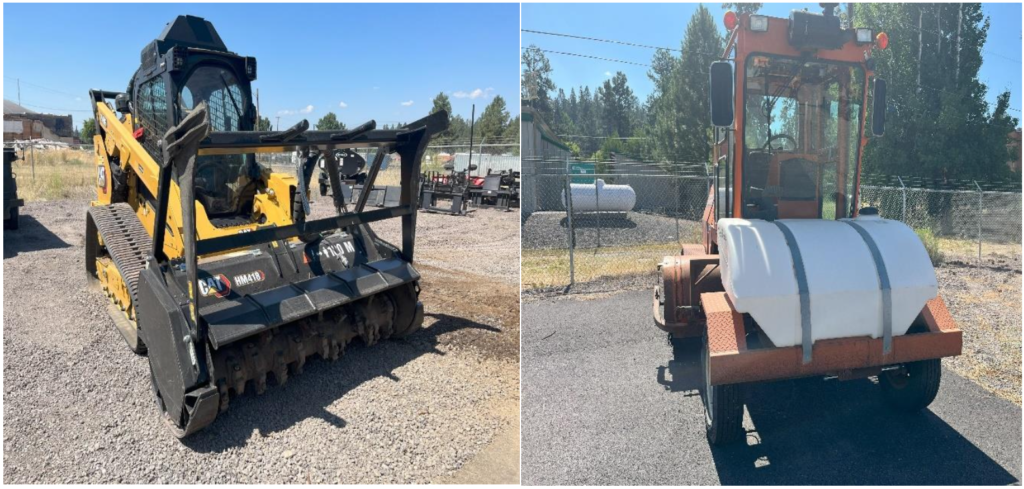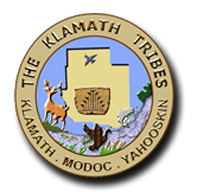FOR IMMEDIATE RELEASE
Date: August 1, 2023
Contact: Ken Smith, Public Relations Director kenneth.smith@klamathtribes.com ; 541-783-2219 ext. 147
Download full .pdf press release
Klamath Tribes Invests in Equipment and People to Work on Tribal Roads and Infrastructure
CHILOQUIN, Ore. – Jared Hall is the Klamath Tribes Planning Director and Les Anderson the Transportation Manager. Both men are currently working on the Klamath Tribes Planning Department Tribal Transportation Plan as they initiate tribal transportation infrastructure in an effort to maintain tribal roads and tribal infrastructure directly. Through the Bureau of Indian Affairs and Federal Highway Administration, federal funds allow for maintaining the tribal roads, buildings, and tribal transportation facilities to meet the needs of the Klamath Tribes’ growing infrastructure. Finding outside contractors to do the work has been challenging, so the Tribes have taken the initiative to oversee much-needed road maintenance. To tackle these projects, they have invested in equipment and crews.
“We determined that if these guys can do it, why can’t we?” said Hall, in reference to outside contractors. “Then if we build this internal capacity and expand the program, we will no longer have to go through the slow, painstaking process of going out to bid solicitation and seeing if there’s contractors will come and do the work.”
Some of the equipment purchased includes an excavator to clear out drainage systems and undertake minor road work, a skid steer with a mulcher head for clearing right of ways, a large lighted street sign to provide traffic information during ongoing projects, and road work, a street sweeper and many attachments for the skid steer. Clearing of the right of ways and excessive brush is also part of fire mitigation on tribal property, which is all the more critical during the ongoing battle to protect tribal buildings and structures from wildfires.
“This year is really a training year and getting familiar with the crew and equipment and with the crew coming on late into construction season,” said Anderson. “Our fall projects, though, are when things will start kicking in because we’ll go right into fall where we can do maintenance. So, you see all the parking lots with cracks; even ours is a new facility here, and it already has cracks in it. We’ll come in and do crack-sealing, fog coating, and restriping. And then we’ll be ready to go in the winter, and next spring is when we’ll probably go into a little more in-depth detail on the road: road construction and maintenance types of projects. And like out at aquatics, once they’ve built their ponds, we will come in and go ahead and be able to do their groundbreaking and probably be able to do most of the roadwork ourselves.”
“Funding has been built up over the years to the point where the Tribes have a healthy Road Fund,” said Hall, “which will go towards infrastructure work on tribal roads from Chiloquin, Beatty, and into Klamath Falls.” Extending road lives, introducing new pavement overlays to improve them, and reconstructing parking lots like the one at the Tribes’ Administration building are just a few of the projects planned for the near and foreseeable future.
Hall said they are also in the planning stages of a larger project at the Kla-Mo-Ya Casino, where the Tribes own quite a bit of land for further development on and around the casino. Still, the location of the properties by Highway 97 involves public right-of-way issues that must be resolved before moving forward with any projects.
In Chiloquin, the Tribes’ Planning Department is working with the city and the Oregon Department of Transportation to establish a partnership for funding and coordinating projects. These projects include constructing new sidewalks and a pedestrian multi-use pathway between tribal properties leading to the Administration building, as well as a planned lighted crosswalk between the Tribes’ Fitness Center and Administration building. It’s also the location where two fatalities have occurred in the last two years involving pedestrians hit by vehicles while crossing the street. Hall and Anderson are also working on a speed zone study to reduce the speed limit from 50 mph to 35 mph on the stretch of road from the Highway 97 turnoff to the 35 mph transition point just past the fitness center. Currently, it is a 50 mph zone from the turnoff to the transition point.
“The city, ODOT, and ourselves have been participating in going after state and federal funds grant programs to build out an area-wide city project, which will include a lot of our tribal properties,” said Anderson. “But it’s tough because it’s complex. All the projects together add up to about $15 million – that’s in 2018 prices. With inflation, it’s probably a lot more now. And so, we don’t know what will happen. But this fall, we’ll find out if the city gets awarded that grant. And we’ll be participating with them to try to build that infrastructure out for the city and the safety of the children. A lot of the tribal members and programs, including health services, reside in the city. So, it’ll be a good thing for everybody to see that infrastructure go in. For our young kids and our people that don’t have vehicles, they’ll have a safe way to get from point A to point B in town without worrying about the dangers of being in the roadway.”
The Planning Department expects to hear from the ODOT this November to confirm the funding amount, which will dictate how much of the planned projects can be initiated.
“They’re literally trying to build this infrastructure from the schools on one end of town all the way across through town all the way up to Highway 97,” Hall said. “That’s going to be a lot of concrete and a lot of curbing and infrastructure, and they don’t know if that’ll fit. They don’t even know if that’ll be enough to do it. Maybe with our support, we could button up a few loose ends with some of our funding, but we’ll definitely be a part of the design team and the implementation team to make sure it’s seen all the way through.”
“We’ll have to see; it’s hard to tell. The ODOT feels pretty optimistic that the city will get the funding. And if they do, that’d be great. We’ll be here helping. But like Les said, we’re willing to take on some of the projects that fit some of our needs right now because of the commercial footprint we have inside the city with our housing and our commercial operations. So, we will do some of it regardless. We’ll probably move forward in November. I would say, one way or the other.”

A new skid steer (left) and street sweeper are two of several large pieces of equipment purchased by the Klamath Tribes to service tribal roads and infrastructure. (Photo by Ken Smith/Klamath Tribes. Image available for media use.)
About The Klamath Tribes
The Klamath Tribes primary mission is to “protect, preserve and enhance the spiritual, cultural and physical values and resources of the Klamath, Modoc and Yahooskin Peoples by maintaining the customs of our ancestors.” The heart of Tribal life is centered in the area of Chiloquin, Oregon and includes 12 Departments, Health Clinic, Childcare Center, Tribal Court, goos oLgi gowa Center, Research Station, and three tribal enterprises. The Klamath Tribes’ 12 departments facilitate service delivery to multiple aspects of tribal life, including health and fitness, education, economic development, social services, cultural preservation, natural resource protection and more. For more information visit https://klamathtribes.org/.





